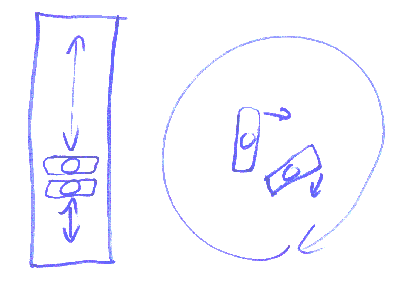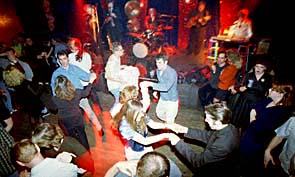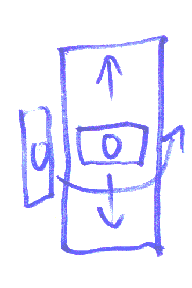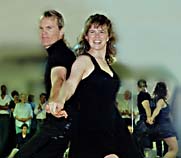East Coast Swing, West Coast Swing
and
Hustle (or Swing Hustle)



- This is a simple explanation just to get across the most visible differences.
Trying to assign two basic style families to swing patterns and fit them
all into east and west coast really isn't totally correct but it helps
when trying to get a basic idea. That is the limited purpose of this
page.
For more on West Coast Swing and other swing dances see:
US Swing Dance Server's What is West Coast Swing article - rhythm counts, styling and origins.
Bob Thomas' Swing Dance Lexicon.
- The most obvious differences between West
Coast Swing and East Coast Swing are in the shape of their patterns.
East Coast Swing is circular with the couple moving around and around using some considerable space. The lead and follow movements generally mirror one another - where the lead takes a step left the follow takes a step right and so forth.
West Coast Swing moves up and down in a narrow "slot" taking a compact amount of room. Both patterns remain over the same area of floor space (rather than moving around the perimeter of the floor in line-of-dance (LOD) fashion). The lead and follow generally do different things with the follow moving up and down the slot and spinning and turning within it. The lead generally moves a smaller distance up and down the slot and moves around the follow as the follow moves through the slot.
These swing patterns also have a lot of variations under a number of names.
EC-type names include east coast swing, jitterbug, Lindy hop, jive, and boogie-woogie.
WC-type names include west coast swing, push, whip, and shag.
What we now call East Coast is from the earliest patterns from the 20's and 30's. The Lindy Hop (Savoy style), jitterbug and other swing dances of the period used a lot of room on the dance floor and were danced in the large ballrooms of the time. After World War II swing music, swing dancing and dancing in general took an incredibly fast nosedive in popularity along with a loss of large ballrooms.
Dancing moved more into small club space and rythm and blues music was more prevalent. These changes prompted development of West Coast swing which allowed for more dancers in a smaller area (with fewer people getting kicked by the dancers next to them). The linear pattern also worked better for bluesier, jazzier music. The somewhat slower music allowed dancers to express nuances of movement and feeling which were too hard to incorporate into the faster patterns.
The easiest pattern to pick up quickly is the East Coast. A bar lesson for an hour or two should prepare you to add dance fun to your party nights. The West Coast is a little trickier to get on to but with a few lessons and some minor effort you can be doing a West Coast in blues places and "expressing" your jazzier feelings. Of the two patterns West Coast is arguably more adaptable to a wider variety of music although both can handle a wide array of music types and speeds.
Music which swings is not necessarily all "swing" music. Even when we say swing we need to remember that during the 30's and even 40's music magazines and musicians were forming definitions for both swing and jazz. Often the terms were used interchangeably or even debated as to whether the term deserved to exist. A famous quote from one musician stated there was no such thing as swing as as separate category. It was just how the music was played. In that context most anything could be played with swing in the beat.
That swing in the beat is generally identified as an emphasis at about two-thirds or three-quarters of the way between two beats in 4/4 time. You can almost feel the music sort of roll like a wave at that point. A lot of what we now often call "classic rock" from the 50's, 60's and 70's has good swing in the beat. Swing dance patterns work very well with a lot of great rock and hillbilly and more. This makes swing a very versatile dance form. It would be tough to do the same mix 'n match thing with waltz or tango although you can find a number of good pop tunes which work for rhumba and cha-cha.
I should note that for this very broad-brush treatment I am including Lindy hop with the six-count east coast patterns because of its circular movement the Lindy's actual step pattern differs somewhat from what we normally call East Coast. Lindy is more strictly an eight-count pattern and generally starts with a "rock step." I will avoid talking about actual foot-step patterns on this page. It is outside my intention for this quick intro.


Hustle is danced to much faster tempos yet it is a smooth, spare, clean , very sophisticated and very elegant dance with a lot of subtlety which is not aways seen if you haven't taken hustle lessons - especially private lessons. It's trickier to master than it looks at first glance and it has its own distinct kind of continous and fluid movement. Disco music is really very smooth and swift with constant movement and so is this dance. Dancers who are good at this are wonderful to watch.